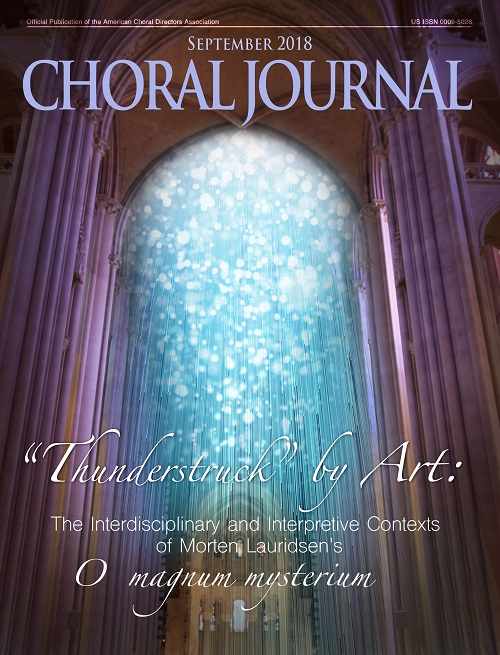The latest issue of Choral Journal is available online! ACDA members can log in with their username and password to view and download the newest edition. You can also read our electronic version. Below is a preview of the articles you will find in this issue. If you are not already a member of ACDA, join today to start receiving your monthly Choral Journal! Associate members can join for only $45 a year.
Following are the articles you can find in this issue.
“Thunderstruck” by Art: The Interdisciplinary and Interpretive Contexts of Morten Lauridsen’s O magnum mysterium by James Arthur Bond
When he composed the motet in 1994, Lauridsen made regular visits to the Norton Simon Museum in Pasadena, California, where he encountered oil paintings by Francisco de Zurbarán (1598–1664). When he first saw Zurbarán’s 1633 masterpiece, Still Life with Lemons, Oranges and a Rose (see opposite page), he was “thunderstruck” by it: he experienced a powerful “visceral reaction” that fascinated him… Rare among Zurbarán’s other works as the artist’s only signed and dated still life, it served as a dynamic “visual model” as Lauridsen composed O magnum mysterium. The painting illuminated Lauridsen’s intention: “to use the most direct materials to create a profound effect” within the listener.
Agile Development Instructional Framework (ADIF): A New Strategy for Student-Centered Music Education by Brian O. Ackles
“The new national and state standards and redefined teacher appraisal models create a new challenge for music educators: How do we create learning environments that continue the tradition of excellence while incorporating experiences for active student-centered problem solving, collaboration, and accountability? This article presents an innovative solution by implementation of the Agile Development Instructional Framework (ADIF): a new music education teaching strategy based on an adaptation of software development’s Agile Development Philosophy and the “Scrum” methodology.”
The Sacred/Secular Dichotomy in James MacMillan’s Cantos Sagrados by Chris Clark
“Sir James MacMillan (b. 1959) is a Scottish composer and conductor currently teaching at the Royal Conservatoire of Scotland. MacMillan has published and performed many highly regarded works, including four symphonies, a number of concertos, and many choral works. MacMillan draws much inspiration from his Roman Catholic faith, often setting traditional sacred texts for choir. This article discusses many aspects of Cantos Sagrados, such as the poetic content, the dichotomy of sacred and secular, the influence of liberation theology, and musical considerations.”
Excellence in Choral Music: A Chronology of the American Choral Directors Association by Marvin E. Latimer Jr.
The American Choral Directors Association, the most storied professional choral organization in the world, will celebrate its Sixtieth Anniversary Jubilee, February 27 through March 2, 2019, in the place of its birth, Kansas City, Missouri. In the months leading up to the event, Choral Journal will publish several articles focused on ACDA’s rich history and traditions. The present article, the first in the series, offers a chronology of some of the many high points in ACDA’s history. The material was taken from Excellence in Choral Music: A History of the American Choral Directors Association, which is the first in ACDA’s Archives Series (to eventually include a rollover of some of ACDA’s current monographs). Scheduled for release in early 2019, the publication is an outgrowth of the work of the Research and Publications Organization History Subcommittee.
The “Mute” Button: Techniques and Benefits of Silent Rehearsal by Jose “Peppie” Calvar
“Conductors can deploy the mute button in rehearsal to save singers’ voices while developing their audiation skills and refining other physical aspects of their performance that are visible to our audience. It works with singers of all levels and ages. Conductors of children’s choirs constantly seek new and different ways to hold youngsters’ attention. Adult community choirs and church choirs often have one long rehearsal per week, where the long work day and the late hours can often result in diminishing returns in a rehearsal. The mute button can accomplish several tasks simultaneously.”
We Will Remember Them: Marking the Centenary of the End of World War One by Christopher Kiver
“November 11, 2018, marks the centenary of the armistice that brought an end to the First World War. The following repertoire suggestions are suitable for high school, collegiate and adult choirs of varying abilities, appropriate either as stand-alone works or as a small set within a larger concert program. While many of the texts are not specific to the Great War, the recurring themes of longing, loss, futility, resignation, separation, hope, and peace are ageless.”
Robert Elmore (1913-1985) and The Robert Elmore Collection at the University of Pennsylvania by Alfred E. Lunde
“Musicians who live outside the Northeastern United States may not be aware of Robert Elmore’s enormous compositional output or his performances as one of the fine organists of the twentieth century. This column will acquaint the reader with a musician who put his Christian beliefs on paper in the form of hundreds of musical works and shine a spotlight on the University of Pennsylvania archives collection. They have gathered a rich collection of music, letters, papers, programs, and audio recordings from Robert Hall Elmore that is worth visiting.”



Leave a Reply
You must be logged in to post a comment.